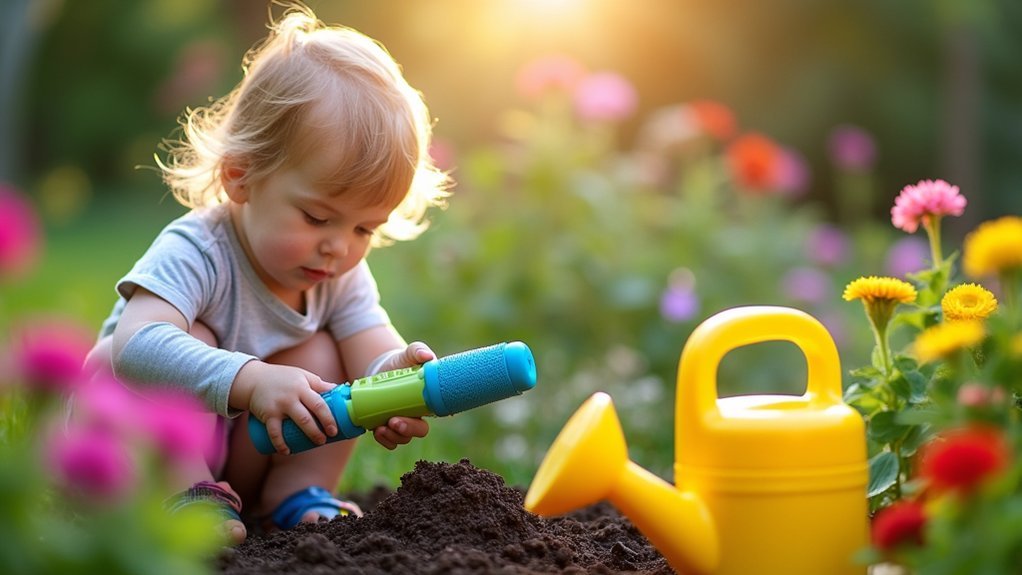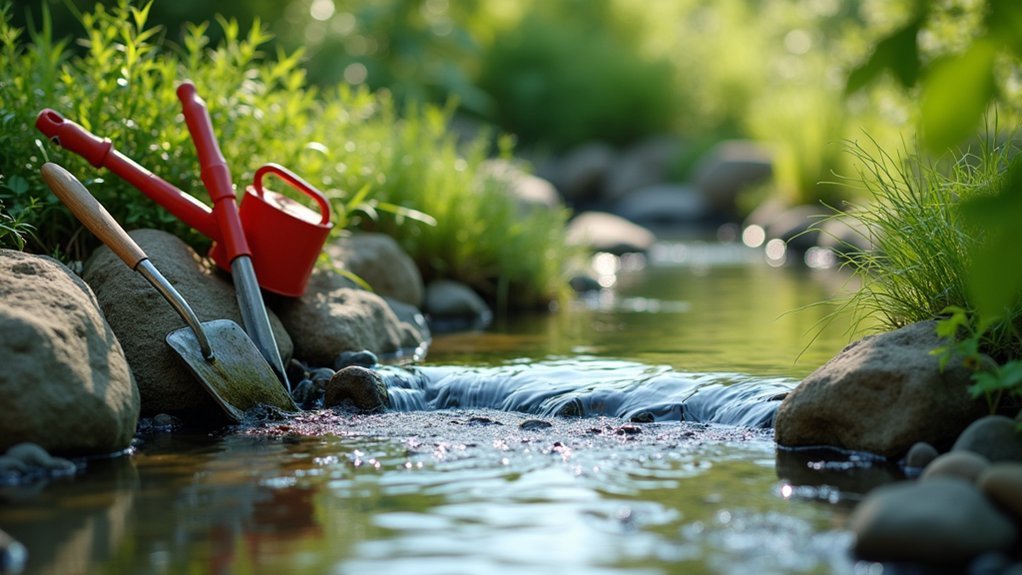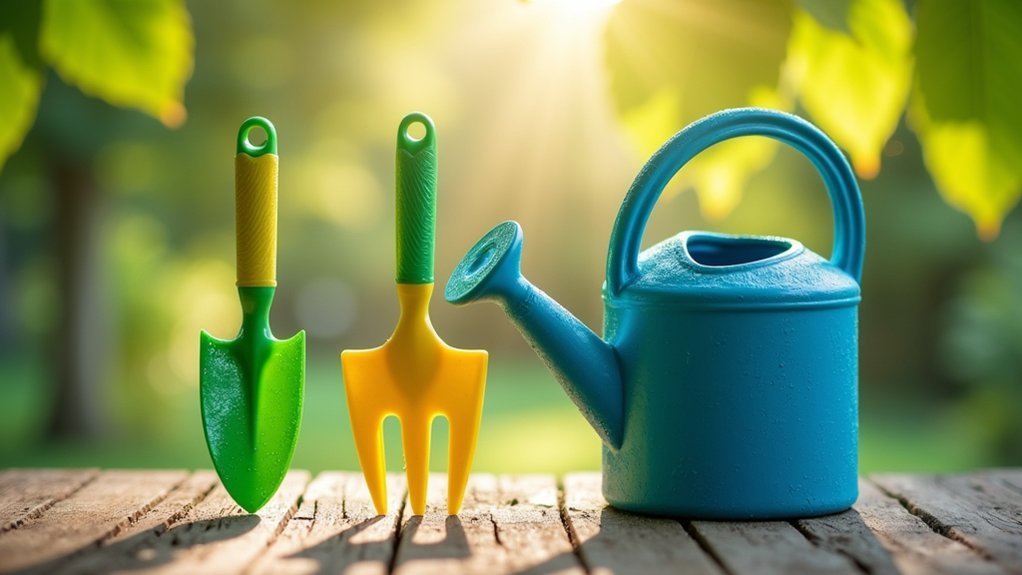For autism therapy success, you’ll find three essential garden tools: sensory-friendly implements with cushioned, textured handles that reduce discomfort; adaptive raised beds that eliminate bending and enhance accessibility; and water features that create calming sensory experiences. These specialized tools support motor skill development, promote independence, and reduce anxiety through multisensory engagement. The right equipment transforms gardening into a therapeutic activity where children can build confidence while connecting with nature in meaningful ways.
Sensory-Friendly Garden Tools for Building Motor Skills and Confidence

The right garden tools can transform therapeutic gardening experiences for children with autism. Select tools with soft, cushioned handles that reduce sensory discomfort while supporting proper grip development.
Sensory-friendly garden tools unlock therapeutic potential, creating success through comfort and proper support.
Lightweight, child-sized options prevent fatigue and enable longer periods of independent activity.
Look for tools with varied textures that provide tactile stimulation—rubber grips, smooth plastic, or wooden handles all offer different sensory feedback. Bright colors provide visual cues that enhance engagement and focus during gardening activities. Breaking gardening activities into small, manageable steps helps reduce frustration and builds confidence while children learn to use new tools.
Tools designed for scooping, digging, and planting naturally encourage both fine and gross motor skill development. When you offer a selection of sensory-friendly options, you’ll empower children to make choices, building confidence as they complete tasks with less adult assistance.
Adaptive Planters and Raised Beds That Support Independence
Beyond specialized tools, adaptive garden environments themselves play a powerful role in fostering independence for individuals with autism.
Customizable planters with adjustable heights accommodate different mobility needs and skill levels, making gardening accessible to everyone.
Raised beds eliminate the need to bend or kneel while providing easy access to plants through shallow soil depths.
Wide pathways guarantee wheelchair accessibility, while supportive rails offer additional stability.
These features are complemented by intuitive designs and clear visual instructions that guide users through the gardening process.
You’ll find these adaptive spaces incorporate sensory-friendly textures and safe, durable materials that reduce anxiety about messiness.
These carefully designed environments promote sensory integration through multisensory experiences that encourage exploration and learning in a safe setting.
Calming Water Features and Tactile Elements for Stress Reduction

Incorporating water features into garden therapy spaces provides powerful sensory support for individuals with autism. Flowing water creates a calming effect on the nervous system, reducing anxiety and mitigating stress responses common with sensory overload.
Consider installing water tables with adjustable flow rates to offer controlled tactile experiences that support self-regulation and focus. The combination of visual, auditory, and tactile stimulation from water elements creates a multisensory environment that promotes integration vital for processing sensory input.
You’ll find that slow-moving fountains or gentle water walls not only soothe the senses but also encourage social interaction and communication through shared activities. These features significantly contribute to decreasing sensory seeking behaviors while promoting calmness and attention, similar to the benefits observed in aquatic therapy settings.
Position these features near shaded retreat zones where children can safely engage with water while developing motor skills, balance, and proprioceptive feedback essential for emotional regulation.
Frequently Asked Questions
How Do You Engage Non-Verbal Autistic Children in Gardening Activities?
You’ll engage non-verbal autistic children in gardening through visual schedules, sensory exploration, picture communication symbols, and consistent routines. Use colorful signs, tactile aids, and simple tools to support their understanding and participation.
What Plants Are Safest for Gardens Designed for Autism Therapy?
Choose non-toxic plants like aloe vera, coleus, and ferns for your autism therapy garden. You’ll want sensory-rich yet safe options like mini succulents and ornamental grasses that offer texture without harmful components.
How Can Therapeutic Gardens Accommodate Wheelchair Users Effectively?
You’ll need flat, non-slip pathways wide enough for turning, raised and contoured planting beds at comfortable heights, accessible seating areas, and automatic watering systems to create an effective wheelchair-accessible therapeutic garden.
When Should Parents Introduce Gardening as Autism Therapy?
You can introduce gardening therapy for your autistic child as early as preschool age. Start when they show interest in nature, can follow simple instructions, and are ready for sensory experiences in a structured environment.
How Do Therapeutic Gardens Differ for Different Age Groups?
Therapeutic gardens adapt to developmental stages: preschoolers need sensory experiences and simple tasks, school-age children benefit from educational elements, adolescents gain vocational skills, and adults focus on wellness and social connection in more sophisticated environments.
In Summary
You’ll find that these three garden tools—sensory-friendly equipment, adaptive planters, and calming water features—can transform your therapy garden into a powerful autism support space. They’ll help develop essential motor skills while creating a sensory haven where independence flourishes. By incorporating these elements, you’re not just building a garden; you’re cultivating confidence, reducing stress, and planting seeds for long-term therapeutic success.





Leave a Reply